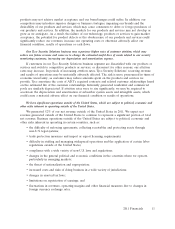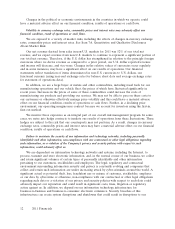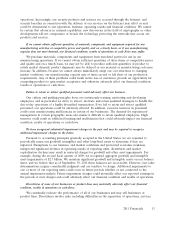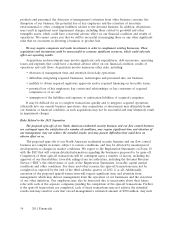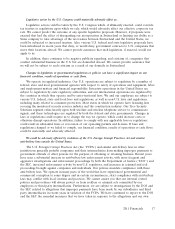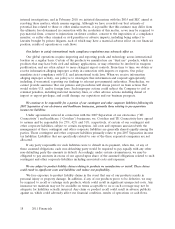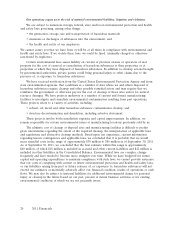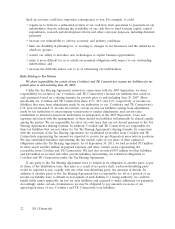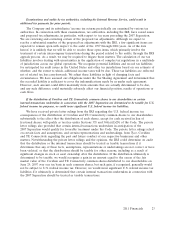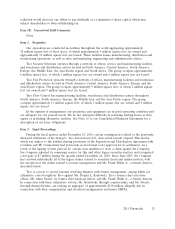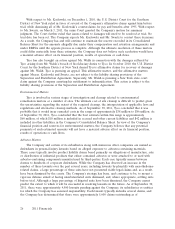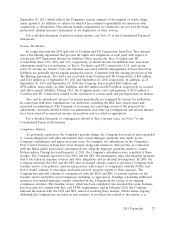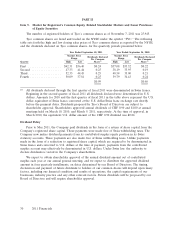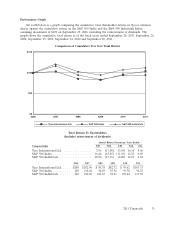ADT 2011 Annual Report Download - page 124
Download and view the complete annual report
Please find page 124 of the 2011 ADT annual report below. You can navigate through the pages in the report by either clicking on the pages listed below, or by using the keyword search tool below to find specific information within the annual report.Risks Related to Our Liquidity
Disruptions in the financial markets could have adverse effects on us, our customers and our suppliers,
as access to liquidity may be negatively impacted by disruptions in the credit markets, leading to increased
funding costs or unavailability of credit.
In the normal course of our business, we may access credit markets for general corporate
purposes, which may include repayment of indebtedness, acquisitions, additions to working capital,
repurchase of common shares, capital expenditures and investments in the Company’s subsidiaries.
Although we believe we have sufficient liquidity to meet our foreseeable needs, our access to and the
cost of capital could be negatively impacted by disruptions in the credit markets. In 2009 and 2010,
credit markets experienced significant dislocations and liquidity disruptions, and similar disruptions in
the credit markets could make financing terms for borrowers unattractive or unavailable. These factors
may make it more difficult or expensive for us to access credit markets if the need arises. In addition,
these factors may make it more difficult for our suppliers to meet demand for their products or for
prospective customers to commence new projects, as customers and suppliers may experience increased
costs of debt financing or difficulties in obtaining debt financing. Disruptions in the financial markets
have had adverse effects on other areas of the economy and have led to a slowdown in general
economic activity that may continue to adversely affect our businesses. These disruptions may have
other unknown adverse affects. Based on these conditions, our profitability and our ability to execute
our business strategy may be adversely affected.
Covenants in our debt instruments may adversely affect us.
Our bank credit agreements contain financial covenants, including a limit on the ratio of debt to
earnings before interest, taxes, depreciation, and amortization and limits on incurrence of liens and
subsidiary debt. Our indentures contain customary covenants including limits on negative pledges,
subsidiary debt and sale/leaseback transactions.
Although we believe none of these covenants are restrictive to our operations, our ability to meet
the financial covenants can be affected by events beyond our control, and we cannot provide assurance
that we will meet those tests. A breach of any of these covenants could result in a default under our
credit agreements or indentures. Upon the occurrence of an event of default under any of our credit
facilities or indentures, the lenders or trustees could elect to declare all amounts outstanding
thereunder to be immediately due and payable and terminate all commitments to extend further credit.
If the lenders or trustees accelerate the repayment of borrowings, we cannot provide assurance that we
will have sufficient assets to repay our credit facilities and our other indebtedness. Furthermore,
acceleration of any obligation under any of our material debt instruments will permit the holders of our
other material debt to accelerate their obligations, which could have a material adverse affect on our
financial condition. See Item 7. Management’s Discussion and Analysis of Financial Condition and
Results of Operations.
Material adverse legal judgments, fines, penalties or settlements could adversely affect our financial health
and prevent us from fulfilling our obligations under our outstanding indebtedness.
We estimate that our available cash, our cash flow from operations and amounts available to us
under our credit facilities will be adequate to fund our operations and service our debt for the
foreseeable future. However, material adverse legal judgments, fines, penalties or settlements arising
from litigation and similar contingencies could require additional funding. If such developments require
us to obtain additional funding, we cannot provide assurance that we will be able to obtain the
additional funding that we need on commercially reasonable terms or at all, which could have a
material adverse effect on our financial condition, results of operations or cash flows.
2011 Financials 21


